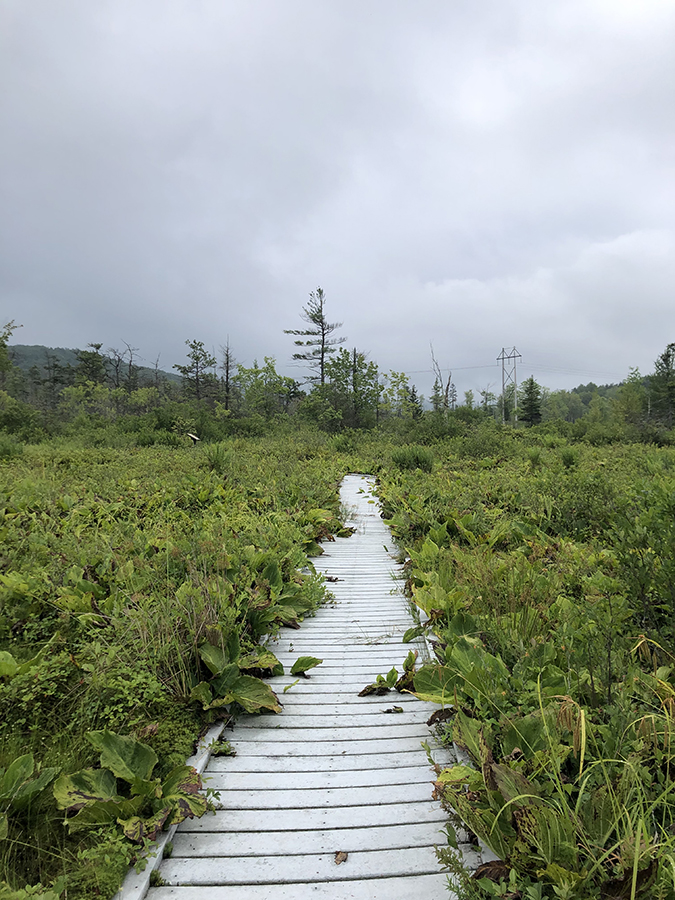by Kristen Smeal, ABG Co President
While traveling to visit family in Central Appalachia this Summer, I visited two sphagnum (peat) moss bogs; the Cranesville Swamp Preserve and Black Moshannon State Park.
These two regions are similar in that they are at higher elevation in a basin-shaped landscape, which traps cooler, heavier air, making for cooler summers and colder winters. Sometimes known as a “frost pocket,” or area between hills that capture moisture and cold air, these bogs more closely resemble habitats found farther north in Canada. There are a variety of plants that grow in the bogs, including cranberries, blueberries, sedge, swamp rose, and many more, but I was specifically on the lookout for carnivorous plants.
Peat bogs are made of compacted sphagnum moss, which create an acidic and low nutrient environment for plants to grow. Carnivorous plants thrive in these environments by eating insects to supplement minerals missing from the bog growing environment.
Cranesville Swamp

Photo: Kristen Smeal
The Cranesville Swamp is a hidden gem, tucked deep in the hills of West Virginia. There was no signage to get there, which I’m not sure was deliberate or not. The area is protected and maintained by the Nature Conservancy, and rests on the border of North Eastern West Virginia and Western Maryland. Its rare habitat makes it one of the coldest, soggiest areas in West Virginia. There are five hiking trails and a 1500 ft. boardwalk through the swamp that takes you through the peat bog. Along the boardwalk, in the marshy areas, is where the sundew (Drosera rotundifolia) grows.
The round-leaf sundew can be found in wetlands in much of the northern hemisphere, and is identifiable by its round, spiky, reddish leaves with drops of glistening nectar, which is what traps insects who stop by for an unsuspecting sip. The tentacle curls around the insect and digestive enzymes go to work, turning it into nutrients for the sundew.
Black Moshannon State Park
Black Moshannon State Park is a 3,394 acre lake and marsh area within Moshannon State forest in Central Pennsylvania. The “Black” part of the name of the park comes from the color of the water, which is a dark tea-color from the tannins in the decomposing sphagnum moss in the bog. A 1200 ft. boardwalk extends over a portion of the 250 acre lake and bog to allow a preview of the marsh and aquatic plants growing there. Three carnivorous plants can be found in the natural bog– pitcher plant, bladderwort, and sundew.

Photo: Jason Poorman
The pitcher plant (Sarracenia) resembles a long hollow tube. When an insect crawls into the pitcher plant, it falls into a pool of digestive enzymes at the bottom. Tiny, downward pointing hairs within the cavity make it difficult for a trapped insect to escape, so it is digested for food.

Photo: Jason Poorman
Bladderwort (Utricularia) is an aquatic plant that resembles floating seaweed with small nodules (bladders) that have hairs, which are triggered by the touch of an insect. The lid to the bladder will then open and snap shut, trapping the insect. I wasn’t able to get a look at this plant during my visit, but it is said to be more obvious depending on the season when the yellow flower blooms.
It’s interesting to learn about the evolution of these plants, which adapted out of necessity in the face of nutrient-depletion. It’s especially fascinating to see them growing in the wild. Carnivorous plants can apparently be found in the bogs and seeps in the Northern Sierras and on the North Coast of California. Perhaps I’ll take another trip!
If you’d like to grow your own carnivorous plants or learn more, Alameda neighbor and carnivorous plant expert- James Fong- of Fong’s Ferocious Foliage, is an excellent resource for both plants and information. You can contact James at (fongsferociousfoliage@gmail.com) and follow him on Instagram (@fongsferociousfoliage)
Photos by Jason Poorman and Kristen Smeal
